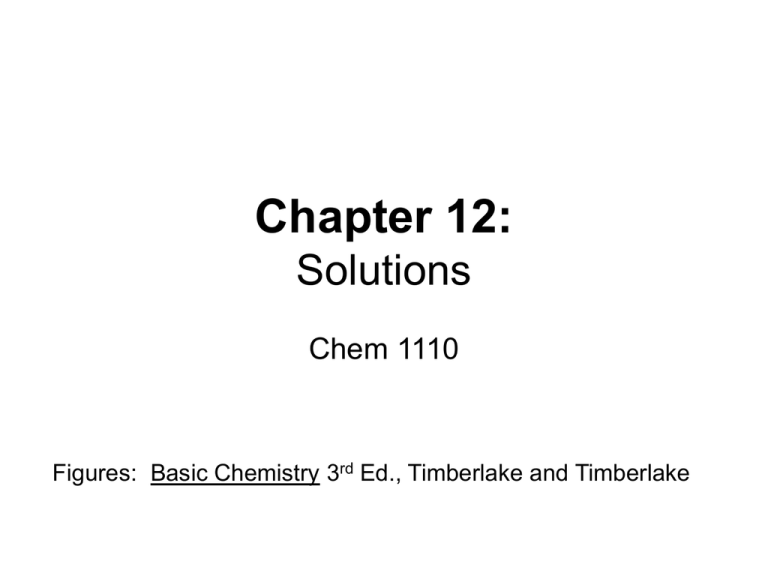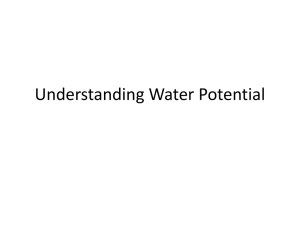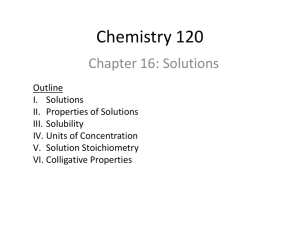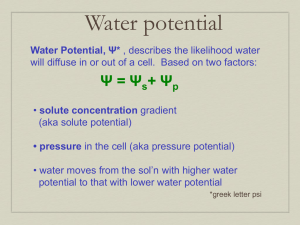
Chapter 12:
Solutions
Chem 1110
Figures: Basic Chemistry 3rd Ed., Timberlake and Timberlake
Examples of Common Solutions
Solid Solutions:
• Brass (65% Cu, 35% Zn)
• White Gold (60% Au, 40% Pt)
Liquid Solutions:
• Vinegar (95% water, 5% acetic acid)
• Solutions used in lab
Gas Solutions:
• Air (78% N2, 20% O2, 1% Ar, 0.5% CO2, 0.5% H2O)
Solutions
We need to define the important components
in a solution:
• Solvent: The most abundant substance in
a solution
• Solute: Any substance dissolved in the
solvent
• Aqueous Solution: a solution of any solute
in water. Water is the solvent.
Solid Solutions
Solid Solutions: An Alloy is a solid solution
of metals:
• Brass (65% Cu, 35% Zn)
• White Gold (60% Au, 40% Pt)
• If one of the metals is mercury (Hg) we call
this solution an amalgam
• Amalgams were commonly used in older
dental work
Solutions
Concentration is the amount of solute in a
given volume of solution
• Concentrated Solution has a large amount
of solute per volume
• Dilute Solution has a small amount of solute
• This is a Qualitative distinction, of course we
will have to consider Quantitative values
Saturated Solutions
We can add solute to a
solvent until NO more solid
will dissolve to form a
Saturated Solution
• Saturation defines the
solubility of the solute
• Solubility is the maximum
amount of solute that can
be dissolved in a given
solvent
Solubility
Solubility is based on:
1. Pressure applied to the system
2. Temperature of the solution
3. Nature of the solvent and solute interaction
Solubility in Water
Solubility increases as temperature increases:
Supersaturated Solutions
If we heat a saturated solution to dissolve
more solute, we can create a Supersaturated
Solution:
• Supersaturated Solutions are:
• An Unstable State because there is too much
solute for the amount of solvent
• Will precipitate out very easily
• Used to make hot packs for injuries
Solubility
Temperature and Pressure affect solubility:
• For solid or liquid solutes:
• Increasing T, increases solubility
• Supersaturated Solution
• Increasing P has NO effect on solubility
• For a gaseous solute:
• Increasing T, decreases solubility
• Increasing P, increases solubility
Henry’s Law
Attractive Forces in Solutions
Interactions between solutes and solvents that:
• are similar in polarity will form a solution
• are not similar will not form a solution
“Like dissolves like”
Water as a Polar Solute
Solubility
Two liquids that dissolve into each other are
said to be miscible
• If you consider Intermolecular Forces:
“Like dissolves like”
Ethanol and water are miscible
Hexane and water are immiscible
Like Dissolves Like
Solvents
Solutes
Water (polar)
CH2Cl2(nonpolar)
Ni(NO3)2
(polar)
I2 (nonpolar)
Units of Concentration
We report the concentration of solutions in
many different units:
• There are several important Career specific
units to consider:
• Percent by Mass (m/m)
• Percent by Volume (v/v)
• Concentrations in chemistry are most often
reported in Molarity (M)
Percent by Mass
Percent by Mass (m/m) is used most often in
engineering or agricultural applications
• Commonly measured in grams
Percent by Mass = mass of solute x 100%
mass of solution
• 6.0 % (m/m): 6.0 g of solute dissolved in a total
of 100 g of solution (6 g solute and 94 g solvent)
Percent by Mass
Low fat milk has 1% (m/m) milkfat
• This means that in this sample of
milk there is…
© Brooks/Cole, Cengage Learning. All rights reserved.
Percent by Volume
Percent by Volume (v/v) is used most often when
both solute and solvent are liquids or gases:
Percent by volume = volume of solute x 100%
volume of solution
• 17.0 % (v/v): 17.0 mL of solute dissolved in a
total of 100 mL of solution (17 mL solute and 83
mL solvent)
Percent by Volume
Rubbing alcohol is 70% (v/v)
isopropanol in a solution with water
• This means that in the bottle
there are…
© Brooks/Cole, Cengage Learning. All rights reserved.
Molarity
Molarity (M) is the unit of concentration most
often used in chemistry labs:
Molarity (M) = moles of solute
1 liter of solution
• A solution that has 1 mole of solute dissolved in a
total of 1 liter of solution is said to be 1 molar (1 M)
Molarity (M) = moles
liter
Learning Check
How many grams of CuSO4 (159.10 amu) are needed
to make exactly 500 mL of a 1.00 M solution?
Learning Check
How many moles of CuSO4 are in 150 mL of
the 1.00 M solution?
Dilution
We decrease the concentration (or dilute)
aqueous solutions by adding water
• The moles of solute STAYS THE SAME
• The volume of the solution changes
• Results in a change of molarity (M)
Molarity decreases
Dilution
In a dilution:
• water is added
• volume increases
• concentration decreases
Dilution
Initially:
Molarity (M1) x volume (V1) = # moles solute
After Dilution:
New molarity (M2) x volume (V2) = # moles solute
# moles solute = # moles solute
M1V1 = M2V2
V2 = V1 + Vadded
Dilution
What is the molarity of a the final solution after diluting
150 mL of a 1.0 M CuSO4 solution with 200 mL of
water?
Molarity in a Chemical Equation
How many milliliters of a 3.00 M HCl solution
are needed to react with 4.85 g of CaCO3?
2HCl(aq) + CaCO3(s)
CaCl2(aq) + CO2(g) + H2O(l)
Learning Check
How many liters of H2 gas at STP are produced when
6.25 g of Zn react with 20.0 mL of a 1.50 M HCl
solution?
Zn(s) + 2 HCl(aq)
ZnCl2 (aq) + H2(g)
Colligative Properties
Homogeneous solutions may have different physical
properties than the pure substances that they contain
• Properties of substances in a solution may be
different:
– We will talk about adding nonvolatile solute leads to
• Increased melting point
• Increased boiling point
• Decreased vapor pressure
Colligative Properties
Colligative Properties are properties of
solutions that depend on the number of
particles dissolved in the solvent
• Colligative Properties do not depend on
the identity of the particle:
o Ions
o Covalent Molecules
• It is the concentration of particles that
matters, particle molarity
Colligative Properties
Dissolved Particles in a solution:
• 1 sugar molecule → 1 sugar molecule
o Total of 1 particle in solution
• 1 NaCl formula unit → 1 Na+ ion + 1 Cl- ion
o Total of 2 particles in solution
• (NH4)3PO4 →
Particle Molarity
Dissolved Particles in a solution:
• 1 M sugar molecule → 1 M sugar molecule
o Total of 1 M particles in solution
• 1 M NaCl formula unit → 1 M Na+ + 1 M Clo Total of 2 M particles in solution
• 1 M (NH4)3PO4 → 3 M NH4+ + 1 M PO43o Total of 4 M particles in solution
Learning Check
What is the molarity of particles in a solution of 125 g
of MgCl2, a strong electrolyte, dissolved in 0.500 L of
water?
Colligative Properties
A large number of solute particles may cause
interruptions or “get in the way” of the solution
surface:
• Dissolved particles may disrupt intermolecular
forces
• The pure substance is “diluted” by the solute
• Decrease solvent-solvent interactions on the
surface
Colligative Properties
Solute particles (ionic or molecular) can:
• Interrupt the intermolecular forces holding the
molecules of a solvent together
• Weaken the intermolecular forces of the solvent
• “Get in the way” on the surface of a solution
and make it more difficult for molecules to
escape
Colligative Properties
Colligative Properties may include:
1. Boiling Point Elevation
2. Freezing Point Depression
3. Osmotic Pressure
Colligative Properties
Effect on Boiling Point…
It is common to add salt to water when boiling, why?
• Adding a non-volatile solute may lower vapor
pressure
• Ions interfere with solvent-solvent interactions on
the surface
• Ions make it harder for water molecules to escape
– Fewer solvent (water) particles on the surface
Colligative Properties:
Boiling Point Effects
• Ions make it harder for water molecules to escape
– Fewer solvent (water) particles on the surface
Colligative Properties
Boiling Point Effects:
• A higher temperature is needed to get the vapor
pressure to equal atmospheric pressure
• DECREASE the vapor pressure of the solution
• INCREASE the boiling point of the solution
• INCREASE number of particles for a larger effect
• Adding salt to water raise boiling temperature:
1 mole of particles raises boiling point by 0.52 °C
• Antifreeze in car engines raises boiling point in
radiator
Colligative Properties
Effect on Freezing Point…
Why do we add salt to roads in winter?
• Salt interferes with intermolecular forces
holding the H2O molecules together
• Water molecules are not able to organize
into ice crystals since solute is in the way
• A lower temperature is needed to reach
the solid state
• The Freezing Point is DECREASED
Colligative Properties
Why do we add salt to roads in winter?
• Salt interferes with intermolecular forces holding
the H2O molecules together
• Water FREEZES at a lower temperature
• Salt prevents roads from re-freezing but it DOES
NOT melt the ice!!
• CaCl2 (Ice Melter®) melts ice and lowers the
melting temperature even colder
The oceans never freeze solid due to higher
salt concentrations
Osmosis
OSMOSIS: the transport of a solvent across a
semi-permeable membrane
• We will limit our discussion to water as the solvent
• Water moves across the membrane to create an
isotonic system
Example of Osmosis
A semi-permeable membrane separates a 4% starch solution
from a 10% starch solution. Starch is a colloid and cannot
pass through the membrane, but water can. What happens?
4% starch
10% starch
H2O
Semi-permeable membrane
Example of Osmosis (continued)
The 10% starch solution is diluted by the flow of water
out of the 4% solution, and its volume increases
• The 4% starch solution loses water, and its volume
decreases
• Eventually, the water flow between the two becomes
equal
7% starch
H2O
7% starch
H2O
Osmotic Pressure
• Water flows from less concentrated to more
concentrated side of a semi-permeable
membrane
• Movement of water molecules sets up a
pressure differential
• Osmotic Pressure is the pressure required
to make these two sides equal equilibrate
Hypotonic, Hypertonic,
Isotonic Solutions
• Maintaining appropriate solution conditions
are very important in your body and chemistry
• Consider the possible negative effects…
Isotonic Fluid
Consider, an isotonic solution such as blood:
Blood plasma (liquid) should have the same
osmotic pressure as in your red blood cells:
o 5.0% (m/v) glucose
o 0.9% (m/v) NaCl
Red Blood Cell: Isotonic Solution
Dr. Stanley Flegler/Getty Images
• Composition of cell is similar to the isotonic
solution it is in – no significant osmosis
Red Blood Cell in Hypotonic Solution
Hemolysis
David H. Phillips/Photo Researchers
• Water flows into the cell to dilute the solution
inside (from the hypotonic solution)
Red Blood Cell in Hypertonic Solution
Crenation
David H. Phillips/Photo Researchers
• Water flows out of the cell to dilute the
hypertonic solution outside
Colloidal Solution
• A homogeneous mixture, NOT a true solution
o No solute or solvent
• Contains dispersed particles that
are intermediate in size between
those of a solution and those of an
ordinary heterogeneous mixture
• So, have dissolved solids in solvent
o Fog
o Milk
Tyndall Effect
• Colloidal Solutions scatter light (Tyndall Effect):
True Solution:
No Scattering
Colloidal Solution:
Light Scatters
Suspension
Suspension: a heterogeneous mixture
containing dispersed particles that are
heavy enough to settle out under the
influence of gravity:
• Muddy water
• Blood
• Fine precipitates
Colloidal Dispersion
Suspension
• Homogeneous
• Heterogeneous
• Groups of small particles
or individual larger
molecules
• Very large particles, which
are often visible
• Not transparent
• Scatters light (Tyndall
effect)
• Particles settle rapidly
• Particles do not settle
• Particles can be filtered out
• Particles cannot be
filtered out
Solutions, Colloids, and Suspensions
Dialysis
• Dialysis is similar to osmosis
• Uses a semi-permeable membrane that allows
the passage of solvent, dissolved ions, and
small molecules, but blocks the passage of
colloidal-sized particles and large molecules:
Removing Colloidal Impurities
Artificial Kidney Machine










